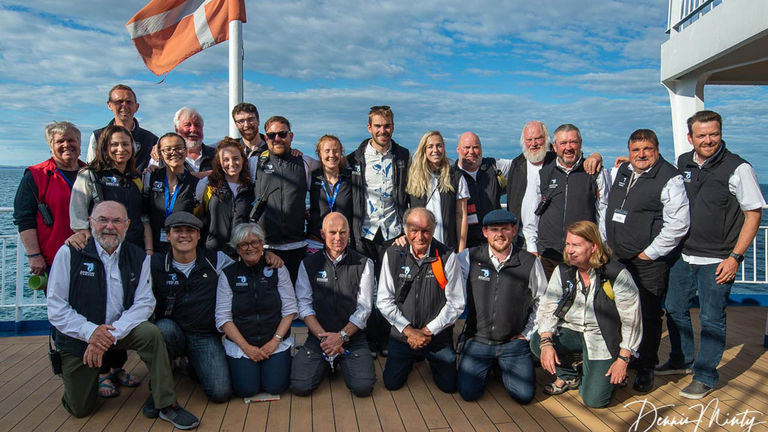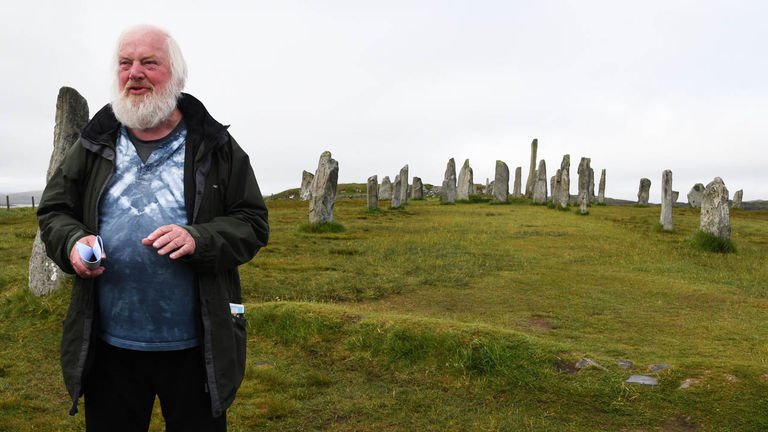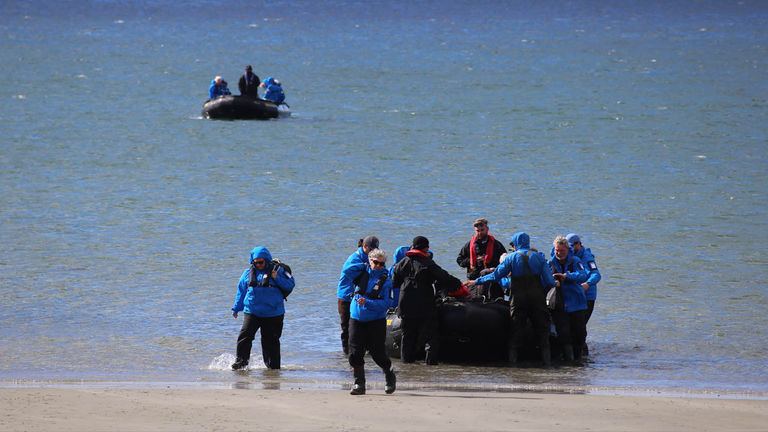We got the bad news during the briefing for the penultimate ports of our Scotland expedition cruise.
The weather at the next day’s intended stops — Papa Stour and Foula in Scotland’s Shetland Islands — was sour, with winds causing swells reaching nearly 1 meter high in opposite directions.
Matthew James “MJ” Swan, one of the three siblings who manages Adventure Canada (AC), broke the news during our nightly expedition briefing.
As usual, MJ detailed the data he was analyzing in order to make his decision, including wind speeds and other weather concerns.
Also as usual, he was ready with solutions. Except for some European itineraries to Scotland, Iceland and Ireland, AC spends the bulk of its sailing season in the Arctic. As such, it’s no stranger to cruising in difficult weather.
MJ proceeded to tell the nearly 200 passengers gathered in the Ocean Endeavor’s (OE) Nautilus Lounge his plan of heading to the Shetland archipelago’s eastern side instead. The island of Mousa was having much better weather.
He then explained what we would do on Mousa: Active options such as hiking as well as interpretive walks by the ship’s guest botanist, geologist and ornithologist would all include a stop to the island’s famous broch (large stone structures dating to the Iron Age). Later that day, the ship would make another surprise stop to Fair Isle, an island known for its incredible puffin community as well as its unique knitting style.
The crew at AC proved themselves to be, time and time again, experts at their craft and some of the finest — and calmest — problem-solvers at sea.
 Each Adventure Canada sailing features a unique expedition team complete with subject-matter and destination experts.
Each Adventure Canada sailing features a unique expedition team complete with subject-matter and destination experts.
Credit: 2019 Dennis MintyWhile this was the 10-night expedition’s only port abort, it was certainly not the first schedule change that had arose. When a few passengers realized that our included excursion to Orkney did not feature Skara Brae, a Neolithic archeological site that has UNESCO World Heritage status, MJ quickly went to work: He organized an optional tour for the multitude of passengers who wanted to visit — not an easy feat in a remote island during peak season.
Adventure Canada’s Exceptional Staff
In addition to involving cruisers in the behind-the-scenes happenings of an expedition, AC imbues each sailing with a collaborative feeling.
This is because AC is a family business. MJ’s father, Matthew Swan, and uncle, Bill Swan, founded the company in 1987 alongside family friend, David Freeze. Most cruises feature a second-generation family member as an expedition leader, whether that be MJ, who serves as director of business development; or his two sisters — Cedar, the CEO, or Alana, the vice president of operations. David Freeze’s son, Daniel, also frequently serves as expedition leader. The result is a warm, intimate feeling that is decidedly not corporate.
AC is also uniquely talented at vetting experts to join each expedition team. On my Scotland Slowly sailing, I was pleased to find out that many of the guest staff were either Scottish or professors. Oftentimes, they were both.
 Ornithologist and conservationist Chris Rollie shares his finding — a bird egg — with a guest on the Scotland Slowly itinerary.
Ornithologist and conservationist Chris Rollie shares his finding — a bird egg — with a guest on the Scotland Slowly itinerary.
Credit: 2019 Mindy PoderJoining my expedition were Chris Rollie, an ornithologist and conservationist; Dawn Bazely, a botanist; David Edwards, a geologist; Ted Cowan, a historian; Lizanne Henderson, a folklorist, historian and singer; Shane Keegan, a marine biologist; Dennis Minty, a naturalist and professional photographer; Kristian Bogner, a professional photographer; Bobby Watt, a musician and stonemasonry expert; and Ian Tamblyn, a folk singer-songwriter and playwright. They complemented in-destination interpretation with onboard presentations, sporadic and lively singing and even themed dinners, where guests could choose to dine with their favorite expert.
Indeed, the expedition crew worked hard to mingle with guests; some of my favorite memories included chatting about academic life with Bazely over a scone during an excursion break; attempting to keep up with Rollie as he led guests on a dramatic birding safari; and listening to onboard host Tamblyn sing the folky “Mingulay Boat Song” as he steered our Zodiac to the island.
 Scottish historian Ted Cowan explains the significance of the Callanish Stones, standing stones located on the Isle of Lewis.
Scottish historian Ted Cowan explains the significance of the Callanish Stones, standing stones located on the Isle of Lewis.
Credit: 2019 Mindy PoderHeck, even Margaret Atwood — the renowned author of several novels, including “The Handmaid’s Tale” — was onboard. Atwood has traveled with AC more than a dozen times, either as a guest or as an author in residence. For our sailing, Atwood was a guest — though she did auction off an edition of “The Testaments,” her much-awaited (and newly released) sequel to “The Handmaid’s Tale.” Proceeds of all auction items went toward two of AC’s conservationist causes.
While many expedition cruises feature an educational element, AC truly goes above and beyond to meet the needs of curious and intellectual travelers.
Onboard the Ocean Endeavour
AC does not own OE, and the ship is secondary to the programming. But that doesn’t mean OE isn’t a comfortable vessel. Expect a warm service team, ample food (including daily afternoon tea) and comfortable — though not fancy — cabins.
My junior suite guestroom, for instance, featured a matrimonial-size bed (slightly smaller than a queen), two nightstands, a sofa bed, a long wooden table, a reading chair, a full-size mirror, a closet, a minifridge and a bathroom. The ship does not have rooms with balconies, but two rectangular windows above my bed framed views of the sea.
 Adventure Canada sails most of its itineraries on Ocean Endeavour.
Adventure Canada sails most of its itineraries on Ocean Endeavour.
Credit: 2019 Kristian BognerOnboard, the opinions about the food were mixed. Some found it well-executed, while others were not overly impressed. While it may not be Michelin dining, the meals always featured a variety of choices and included vegetarian and gluten-free options. The crew also did a great job adapting to real-time requests for more buffets and even specific items. The cuisine was internationally influenced, though some regional specialties — such as haggis (offal), neeps (rutabaga) and tatties (potato) — were served.
Despite the multicourse, sit-down dinners, dining was always a casual affair. Even on the captain’s night, most passengers stuck to comfortable outdoor gear — opting for jeans over dresses and down jackets over blazers. AC provides passengers with a complimentary rainproof jacket, as well as gumboots; all are offered to keep for the duration of the cruise in the comfort of one’s own locker, located in the onboard mudroom.
Indeed, the focus here is not on decadent luxury or produced entertainment, but on immersion in nature and education. Downtime on the ship was spent by most in the company of one of the onboard experts. Among other topics, we learned about botanist Bazely’s doctoral thesis on the feral Soay sheep on St. Kilda — one of the UNESCO World Heritage sites on the itinerary — and how Scotland’s seabirds are impacted by climate change from ornithologist Rollie.
 Because of the use of Zodiacs to reach most ports, clients should expect some wet landings.
Because of the use of Zodiacs to reach most ports, clients should expect some wet landings.
Credit: 2019 Mindy PoderBirders religiously followed Rollie’s checklist, posted on a board in the library hallway, which detailed all the species that were spotted during the cruise. By the end of our 10 nights together, it totaled 83 different birds, from the initial sightings (a shelduck and a common eider) to the final glimpses (a common swift and a yellowhammer).
Even less noble pursuits were related to the destination, such as “the Scottish games,” a competition that had volunteer cruisers bobbing for apples in the ship’s outdoor hot tub, crab walking through the lounge, performing a Scottish dance on a makeshift catwalk and reciting an original poem.
Ideal Clients for Adventure Canada Expeditions
Indeed, the cruisers onboard AC are a good-natured and intellectual bunch, eager to learn and share warm conversations. Most cruisers hail from Canada, though Americans blend in seamlessly.
Like with most expedition cruises, the clientele onboard AC’s cruises skews older. I was told by staff that my itinerary, Scotland Slowly, tends to attract an even older, and less active, set. Unlike the line’s cruises to the Arctic that operate in harsher conditions, the Scotland itinerary offers more opportunities for those with mobility issues to get involved and enjoy the sights. Some ports didn’t even require a Zodiac for disembarkation.
Nonetheless, AC cruises are well-suited to multigenerational groups. Most ports offer a choice of several excursions, including gentle walks to advanced and intermediate hikes. The line is also actively trying to attract younger clientele with its “Save 30% under 30” promotion, which offers a hefty discount on berth costs for travelers under 30 years of age. Children 2 years old and younger travel free, while children 4 years old and younger pay only charter airfare (if required). Adventure Canada also offers a limited quantity of cabins for solo travelers, sans single supplement.
The Details
Adventure Canada
www.adventurecanada.com